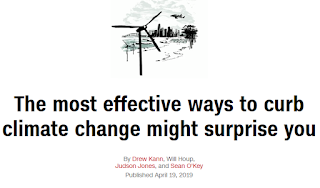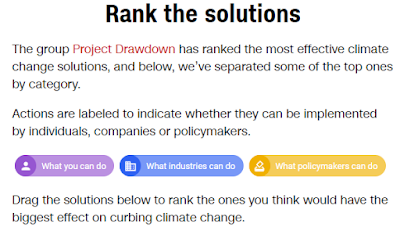CNN created an interactive quiz that will teach your students about a) making personal changes to support the environment, b) rank-order data, and c) nominal data.
 |
| https://www.cnn.com/interactive/2019/04/specials/climate-change-solutions-quiz/ |
The website leads users through a quiz. For eight categories of environmental crisis solutions, you are asked to rank solutions by their effectiveness. Here are the instructions:
Notice the three nominal categories for each solution: What you can do, What industries can do, What policymakers can do.
Below, I've highlighted these data points for each of the "Our home and cities" solutions.
Below, I've highlighted these data points for each of the "Our home and cities" solutions.
There are also many, many examples of ordinal data. For each intervention category, the user is presented with several solutions and they must reorder the solutions from most to least effective.
How the page looks when you are presented with solutions to rank order:
The website then "grades" your response:
The ordinal data is then presented as ratio data. While the data is still described by rank ordering, the data is also described in terms of environmental savings counted in the equivalent number of cars taken off the road. The ordinal difference might be the 1st and 2nd ranking, but the ratio scale difference is 31 million cars.
How the page looks when you are presented with solutions to rank order:
 |
 |
| After |
The ordinal data is then presented as ratio data. While the data is still described by rank ordering, the data is also described in terms of environmental savings counted in the equivalent number of cars taken off the road. The ordinal difference might be the 1st and 2nd ranking, but the ratio scale difference is 31 million cars.



Comments
Post a Comment